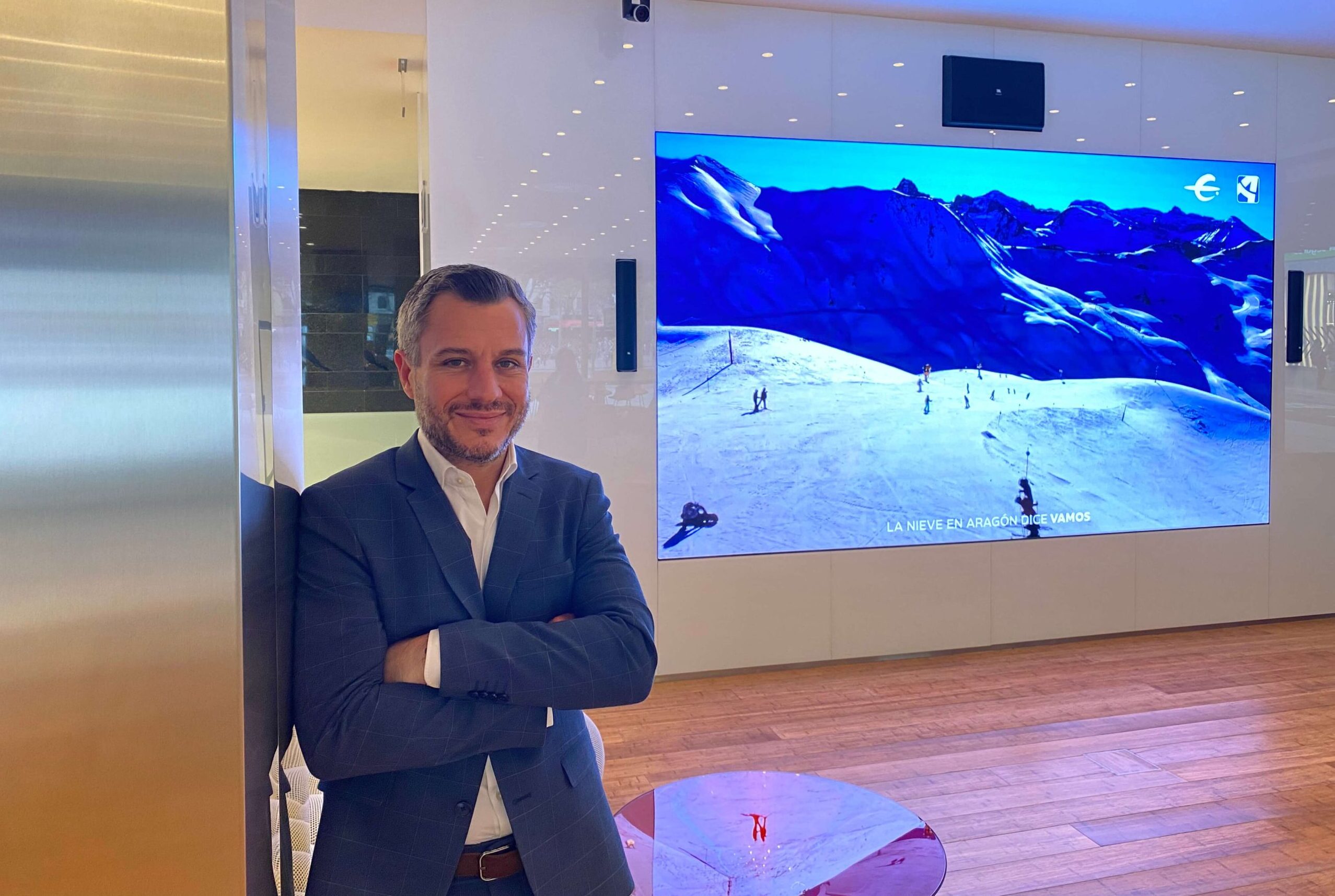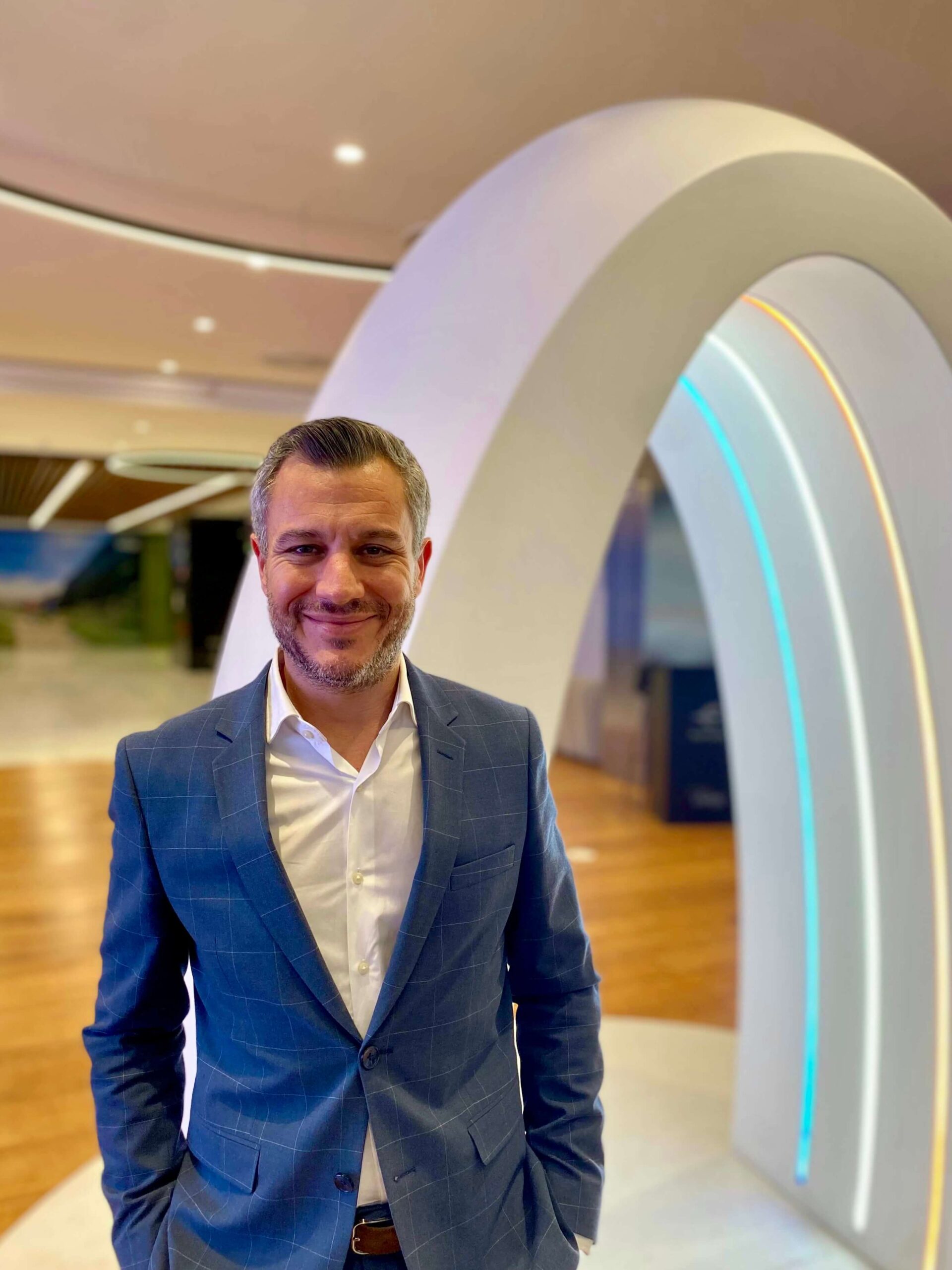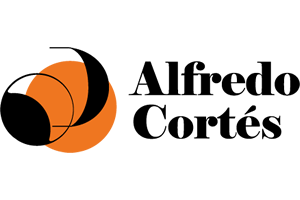Nacho Torre (Zaragoza, 1979) has been director of Marketing and Digital Strategy and deputy director of Ibercaja since 2017. A member of the board of directors of ARAMÓN, Torre is also a PADE from the IESE Business School of the University of Navarra. An Industrial Engineer from the University of Zaragoza, he joined the bank 16 years ago, so he has witnessed first-hand the digital transformation of Ibercaja, as well as the restructuring of the banking sector after the bankruptcy of Lehman Brothers, which led to the economic crisis of the end of the first decade of the 21st century. All this within an institution with 150 years of history that, as he confesses, is guided by a founding DNA that survives today: to work for the development of the territory and its people. With a favorable end to the year, in which the recent opening of the Xplora space in September of this year 2023 stands out (a place that has hosted more than fifty meetings, and has been visited by more than 7,000 people), Nacho Torre takes stock of a not easy cycle that ends with good prospects.
What is your assessment of Ibercaja’s activity during the year 2023, which is about to close?
This year 2023 is a bit special. Financial institutions, not only Ibercaja, are coming from some years that have been quite hard. As a result of the economic-financial crisis at the end of the first decade of the 2000s, the negative interest rates and the previous excesses we had as a country, financial institutions had to adjust their capacity and adjust to the new habits of consumers, who are increasingly digital, although they also want to be attended in person. You adjust offices, you adjust people, you have negative interest rates that make that with credit a financial entity does not make money, you have to sell other products or services with greater intensity…. The balance of the last few years, not only for Ibercaja, is hard. We have had irregular assets, such as loans that have not been repaid, apartments, land, premises…
In the particular case of Ibercaja, in 2022 things started to change. The irregular assets had been managed, we made the capacity adjustment according to what the clients demanded, and in this way the economic-financial situation of the entity became very solvent, even outstanding among the rest of the entities. And, in addition, we had a bit of a tailwind with the rise in interest rates, and that has meant that 2023 has been a very good year. Interest rates will probably go down a little bit, savings may be paid back in their traditional form a little bit more. Mortgages have fallen, in the case of Ibercaja they have been maintained and even increased in market share, there has been less credit for companies, although also in the case of Ibercaja we have increased somewhat in market share. In pension funds, we will be the entity that will have had more contributions in absolute terms. Overall, we can say that 2023 has been a good year, after some tough years.
What milestones and expectations does Ibercaja have for the coming year 2024?
The year 2024 is very special for Ibercaja because we will have a change of strategic cycle. We close the 2021/23 cycle, and we will open the 2024/26 cycle. We are currently in the process of formulating the new strategy, something that has to go through the different governing bodies of Ibercaja. Ibercaja is 100% owned by foundations: 88% by Fundación Ibercaja, and the other 12% by CAI, Fundación Caja Círculo and Fundación Caja Badajoz. Therefore, everything that goes well for the bank will revert to the foundations in the form of social action. At Ibercaja, we make our strategy ourselves. This is a singularity of our entity, and so far in these 150 years we have not done badly.
OUR APP IS IN THE “TOP 3” OF FINANCIAL APPLICATIONS IN SPAIN.
The protagonists of the strategic cycles are people: our customers, whose habits have changed a lot and we want to adapt to this; the bank’s own colleagues, who thanks to technology can be more efficient, productive and collaborate better; and society, because not only because of the dividend that comes from the foundations through philanthropy, but also because the bank itself, thanks to its economic activity, tries to have a positive impact on society, generating welfare.

What are the main challenges you face as Marketing Director of Ibercaja?
We have a triple vision in terms of challenges. On the one hand, there is the customer strategy: who our customer is, where they are, how we are going to reach them, what product they want, what service, what relationship model, what pricing scheme for each of the different segments. On the other hand, how we establish the relationship with the customer in this more digital environment. That has to do with the channels: digital banking, the App, the teller experience, the contact center, the personalization of the relationship through business intelligence (Big Data and marketing automation). And finally, how I attract customers and build customer loyalty (positioning, storytelling, content marketing, digital marketing). Here I am very lucky because I have people like Víctor, Carmen and Sonia, who are the heads of the different units, who make sure that the mission is accomplished.
Ibercaja has received this year the National Marketing Award, given by the Marketing Association of Spain (MKT) in the category of Sponsorship. What do recognitions like this mean in your professional career within the entity?
We feel very satisfied and grateful. I particularly like this award because when the Espacio Ibercaja Delicias in Madrid was chosen, the aim was to democratize access to culture. Madrid has become the third world capital for the quantity and quality of its musicals and shows. These shows at that level, in the theaters of Gran Vía, for example, have a cost, they have an average price per ticket that many families can be an effort. The Ibercaja Espacio Delicias project makes it possible to reduce the average ticket price a lot. We are talking about the most expensive ticket costing 60 euros, when in a theater the cost is much higher. The fact that it has been recognized, with this award, that a company wants to sponsor this type of project, because it understands that it is aligned with its purpose, and that it is going to give it a type of notoriety that suits it, is a source of satisfaction. The fact that there are financial institutions such as La Caixa, which came second in the competition, or Banco Santander, which was among the five finalists, or that the previous winners were Telefónica or Iberdrola, gives a relative image of how complicated it is to obtain this award.
At this year’s Customer Experience Management Forum, he stated that “the experience at Ibercaja is first to deliver, and then to surprise”. How do you surprise the customer in today’s digital society, where messages compete to be heard across multiple platforms?
The average viewing time for a TikTok is six seconds; it’s very complicated. In this sense, moreover, the banking sector is one of those considered in Spain as “not appetizing”: you don’t “feel like” taking out a mortgage, but you do feel like moving out of your parents’ house or having a second home on the beach. You don’t “feel like” asking for a line of financing to export, but you do feel like having international clients. Restaurants, leisure, sports, entertainment or health aesthetics “feel like it”, but the world of banking, energy and other commodities, do not “feel like it”. And that already makes you change the paradigm of what your client expects from you, and what it is to fulfill for him and surprise for you as an entity. And what is to fulfill for him? That you are convenient, that you give him things when he needs them through the channel that is most convenient for him, and that you do not fail. In general, this is what it means for both the individual customer and the company: that, if you go to pay with your card at a restaurant on a Saturday afternoon, the card and the POS work; that if you have the misfortune that it doesn’t work, and you go to an ATM, that there is money. What does it mean to surprise a customer? That in the relevant moments of his life or of his company in which there is a role of finances, you accompany him. Many times you don’t even think about the role of finances, when you are going to buy a house it is very obvious, but it is not the first thing you think about: you look for the house you like. When you decide to invest in a foreign country and you are going to have a change of currency, of course you think about finances, but mainly you think about your business project.
You have witnessed firsthand the digital transformation that banks have undergone in recent years. What have been the keys to being among the first in this transformation?
I start with a key that is not the most decisive: the economic investment capacity in absolute terms. We are competing very well with respect to objective variables such as customer satisfaction or our App in the markets. We are top 3 or top 4 in almost all of them. How do you achieve all this from a relatively smaller size than other financial institutions? Above all, with a lot of observation of your consumer, what he wants, when he wants it, and giving it to him so that he can digest it little by little. Because let’s remember that they don’t “feel like it”.
TODAY IT IS “THE BANK OF LET’S GO”, WE SAY IT IN A WAY ADAPTED TO TODAY’S SOCIETY, BUT IT STILL HAS THE SAME DNA AS 150 YEARS AGO.
That is a fundamental part. The next fundamental part is to have clear ideas: What am I betting on? What is my relationship banking model? What does the customer expect from me? And I try to be consistent over time. And after that, wanting to collaborate and knowing how to collaborate, looking for good partners. Now the world is very global, and there are very good people out there who can be your partner. Our main technological ally is Microsoft. This would be the third key, to have a collaborative ecosystem.
Has Ibercaja considered offering its services in the Metaverse?
We will be wherever the client is, and wherever we are. It is a question of timing. If our consumer gets used to being in virtual environments, whether in Metaverse or in a virtual-augmented hybrid, Ibercaja will be there. What we have to do there is to measure the timing well, we are not going to push him to a place where we don’t know if he wants to be. If he wants to be in the Metaverse, Ibercaja will be there with him. And if he also wants to have a presence, as long as the business model supports it, we will be wherever we are. So far we have had experiences in the field of virtual reality because we are fortunate to have some of the best entrepreneurs in Aragon, Peter and Hector from Imascono, we have made experiences with them especially in the field of entertainment. As leisure and entertainment they seem to work. What the studies say is that the next thing to come is in the field of e-commerce, at least a mixed reality, especially in the shopping experience. We’ll see how it plays out.
In 2018 Ibercaja launched its marketing campaign “El Banco del Vamos” with the aim of positioning itself as the financial institution best valued by its customers in Spain. What balance can you make of the evolution of this renewed image during these five years?
The balance is positive. Before having “El Banco del Vamos”, Ibercaja’s slogan was “We speak with facts”: if I tell you something, it is because I have behavior and data behind me that support that reality. When this slogan was created, it was a defensive move in response to the bad reputation that existed in the sector. As soon as the economic-financial crisis ended, the financial institutions, particularly the savings banks, were blamed for part of the situation. There were indicted executives of companies in the sector, floor clauses, preferential shares, some other complex products… facts that punished the reputation of the sector. Ibercaja had none of that.
THERE WAS FIRE, WHEEL, PRINTING PRESS, STEAM… AND I DON’T KNOW WHAT THERE WILL BE IN A CENTURY. DIGITAL IS NOT THE PROTAGONIST, BUT THE CUSTOMERS.
When the “El Banco del Vamos” campaign was launched, society was already in a different moment, more dynamic and fresh, and the entities began to communicate in a way that was more adapted to that social moment. In “El Banco del Vamos”, the word “bank” is mechano-written, because it is something very serious. The word “vamos” is already handwritten, in the first person plural, because we go together: it is impossible for me as a bank to do well if my clients are not doing well. “El Banco del Vamos” also arises as a recognition of what we have been for 150 years, telling how we do things: in a close and friendly way, by hand… Now we want to make “El Banco del Vamos” even more tangible, to take it more to the product and service.

What are the keys to this innovative process?
It was a precious, introspective process. Ibercaja was born in 1876, at the same time as the telephone, a tool that has changed a lot, but still serves the same purpose, to communicate. The founding origin of Ibercaja was to fight against usury, against financial exclusion, to promote the Christian virtue of saving, and to develop the territory and its people. And today it is “El Banco del Vamos”, we say it in a way that is more adapted to today’s society, but it is still the same. The DNA is the same. You go through very sweet social moments, where it is very relevant (people who fondly remember the bank account they opened for their grandchildren, or how Ibercaja was able to give them the first credit for their company), and you go through other more sour moments, which accompany the economic cycle of the country. But we do not change. One of the keys is that: to know who you are. That is to be authentic.
How have you experienced the evolution of Ibercaja in the 16 years (out of 150) that you have experienced, with the change from the analog to the digital world that has taken place in the world during this period?
I studied engineering at the time, then I worked as a strategic planning consultant, and then I joined Ibercaja. I didn’t know anything about banking, I spent a year learning, and Ibercaja is very conscientious with new recruits so that they can develop. By the time I realized it, Lehman Brothers went bankrupt. I have never known a bank before that. Since then it has been all uphill. Since I joined Ibercaja until today, there has been a very strong, very significant development in the digital field, but it has not been linear, it has been very exponential. At the beginning, it was very flat: from 2008 to 2015, what practically all the entities did was to take the blows as best we could. At Ibercaja they told me something very early on, which I think is very representative of what banking is: a bank is not ruined in a crisis, you ruin a bank in a boom, which is when you can take risks that you should not. And where the joy can lead you to annul the judgment. In Ibercaja there is a lot of judgment, it got out of the real estate sector before the rest of the entities, for example.
AT XPLORA WE WANT THINGS TO HAPPEN THAT CONNECT IDEAS, PEOPLE AND PROJECTS.
In 2015 is when we started to be able to take advantage of the opportunity of the digital economy. We like to talk about business transformation thanks to the digital economy. We transformed ourselves, digital was an enabler. There was fire, there was the wheel, there was the printing press, there was steam… and I don’t know what there will be a century from now. Digital is not the protagonist, it is the customers and us trying to give them value. Between 2015 and 2023 there has been a very strong growth, in terms of investment, in terms of clarity of ideas. This has been seen especially in all the customer relationship channels, everything that has to do with the public web, the logged web, the App, the digital experience at the ATM, content marketing, social networks… This is what we have done in recent years in great depth and it has meant a significant change. One of the keys in this process is to understand the customer: what they demand, what they still want to do in person, what they can do over the phone, and deliver it to them. And, on the other hand, our colleagues, especially those who are in contact with customers. The whole digital economy has also helped them a lot: to organize their commercial tasks, their management tasks, with many more tools than they had in the past, to get to know the customer better…
How do you approach the knowledge of what the “internal customer”, the colleagues of the entity, demands?
I have a dual perspective in this regard, as a member of the management committee and as an employee. The last directors of the People Area, Teresa Fernández, Ana Sangrós, and now Rodrigo Galán, have had a very relevant sensitivity to everything that has to do with employee experience and the world of leadership. In order to develop the entire employee experience from the People Area, they approached the Marketing team to see how we worked on the customer experience. Because the whole employee experience discipline has emerged in the heat of the customer experience area. What are employees? People. And what are customers? People. If in the end we are managing people in the customer dimension, perhaps the same tools can be used to manage people in the employee dimension. Thus a value proposition as an employer emerges, a life cycle as an employer from the point of view of recruitment, professional development, moments of difficulty, moments of uncertainty, disengagement... they have worked on the employee’s life cycle. Then they added the annual employee management cycle: what happens to the employee in a year. You have to do a performance evaluation, evaluate your leaders, if you are a leader you are also evaluated… They have drawn what is expected of an Ibercaja colleague as an employee throughout the year.
We have several listening channels open through work climate surveys, all the legal channels that you must have, and meetings are held. On that basis, specific plans emerge, such as being a Family-Responsible Company, we received the Healthy Company Certificate from AENOR, the bank’s anniversaries, to excite through recognition, excellent teams… All of this makes people in the bank feel considered and listened to.

Xplora is one of Ibercaja’s latest projects in the heart of the city of Zaragoza. It is a meeting point for the promotion of the social, cultural and business life of the city. What is your assessment of this innovative space?
Ibercaja was born in 1876 and its commitment to the development of the territory is essential. It is a virtuous circle of prosperity, well-being and economic development. If the territory does well, the bank does well, and if it does well, it gives a dividend to the foundation, and the foundation can do good in the territory. This has led us to support projects such as the arrival of Opel in Aragon, Expo 2008, the development of the PLA-ZA logistics platform, designations of origin, ARAMÓN…
WHEN I JOINED IBERCAJA I WAS TOLD THAT A BANK IS NOT RUINED IN A CRISIS, BUT THAT YOU RUIN IT IN A BOOM.
When the building where Xplora is located was designed, it was not only intended to be the bank’s headquarters, but also to have an impact. It is possible to leave a beautiful legacy in the center of the city by constructing a steel and glass building, in the style of the buildings that existed in Chicago at that time, in the eighties. Recovering the Patio de la Infanta, Renaissance of the sixteenth century, and installing it in the building itself (in its original place it is not possible because there is the Roman Theater). Forty years later, we want to have a positive impact on the city, on the community, through this space. To this end, the entire first floor of the building has been renovated and the Xplora space has been created. This space is intended to make things happen that connect ideas, people, projects… It is open to everyone. Since the space was inaugurated in September of this year, more than fifty meetings have taken place and more than 7,000 people have passed through it. It is a space open to the public where people can come and enjoy the virtual reality experience, through which they are transported to three moments in history and can see what this square was like at that time, participate in the meetings that may take place, use the tables to hold meetings… That something never stops happening in Zaragoza because there is no place to do it. That was the intention and we believe it is happening.
What can the citizens of Zaragoza find in this space in 2024?
We really like to celebrate some important dates, such as, for example, El Pilar, there will be surprises and an agenda with issues related to Aragon and the Pilar festival, as there were this year. At Christmas there will be again a long agenda of different activities for all audiences. We will also do something on St. George’s Day, which is a very iconic date for our territory. We also have a cycle of Great Explorers in which, when a very relevant person in his or her field of knowledge or specialty comes to the city, we try to bring him or her here. We will also continue to welcome proposals from institutions and civil society, such as the cycle dedicated to Japanese culture, or with the National Police, which brought security issues related to Black Friday in the field of e-commerce, business associations … to the stores.
In addition to being deputy director and marketing director of Ibercaja, you are an engineer and runner. How do these two facets, so characteristic of your education and your personal life, influence all the projects you take on at Ibercaja?
I couldn’t say how I ended up studying engineering. In my time, if you liked literature and you weren’t sure what to study, you went for law, and if you liked science and technology and you weren’t sure, you went for engineering. I liked it a lot while I studied it, I like to make things at home with my hands, something inherent to the human species, it is very comforting. On a professional level, it has helped me to understand two things fundamentally. On the one hand, that everything has a solution: maybe it’s perfect, maybe it’s optimal, maybe it’s the least bad, but everything can be fixed. And that is extraordinary, you have a lot of tools and that gives you a lot of peace, in the end you find the solution, it is a way of working. On the other hand, sometimes I tell the team that my head is like a Rubik’s cube, because I like order a lot, and that also happens when you go through this kind of disciplines like engineering, you value the method a lot. I think about how I’m going to do things, I write it down and I draw it. Reading what I have written makes me think that maybe it wasn’t really the way I had thought it, I put it into practice? I feel very proud to have gone through the School of Engineering at the University of Zaragoza.
AT IBERCAJA WE MAKE OUR STRATEGY OURSELVES. THIS IS A SINGULARITY OF OUR ENTITY.
In the world of sport, and running in particular, this year, if nothing happens, I will have managed to go running every week of the year, at least one day, most of them two and sometimes three. That effort, that sacrifice (many days I didn’t feel like it), you feel that it helps you to disconnect, you feel physically a little better. You take that perseverance back to work. I’ve been running for six years with a group (which has become a group of good friends), and the truth is that it doesn’t cost you the same effort if it’s individual as if it’s shared. Nobody runs for you, but in a team you get along better. And you also take that to the company. Shared efforts are better, celebrated in good company they taste better, and they help you get strength for the next one. Besides, before being an engineer and a runner, I am a father, I have an eleven-year-old daughter, Alba. I have thirty years with my daughter, twenty years with the youngest person on my team, and she has ten years with my daughter. My daughter has been with the youngest person on my team for half as long as I have been with her. In other words, the youngest person on my team is more like my daughter than I am like her. It’s something that ends up being very relevant, because I would like the result of the education I try to give Alba to be the same as what my parents achieved with me: good universal values, reasonable autonomy, knowing how to live in the moment you are in, and being the master of your own destiny. To do that in our parents’ time, to do it now, when you live with cell phones, social networks, a crisis of values (which I think is greater than the one that could be then), with amplifiers of that crisis of values in certain programs that make it even more difficult for you. I think it is more difficult to achieve now what our parents achieved with us. All this reflection leads me to think that with the younger people in my team I will have to do it very differently from the way my bosses did it with me. It is my responsibility as a leader to get the best out of them. And I won’t be able to blame the context, which I am part of, much less them.















